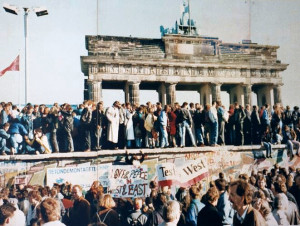
November 9, 2014 will mark the 25th anniversary of the fall of the Berlin Wall. To honor this major anniversary, a series of special events and exhibitions are planned to take place throughout the city, focusing on the division of Germany and Berlin, the Cold War, and the peaceful revolution leading to reunification.
The anniversary year will culminate on the weekend around November 9th with a symbolic installation consisting of illuminated helium-filled balloons along 7.5 miles along the former inner-city border. Hundred thousands of locals and visitors will have the opportunity to stroll along the illuminated path and get a feeling of the intensity and extend of the city’s division. Just like in 2009 (20th anniversary of the fall of the Wall), all attention will be focused on Berlin’s center.
It is the goal, to create an atmospheric event that honors and commemorates the peaceful revolution and the subsequent fall of the Wall as a “symbol of hope for a world without walls”. In clear weather, the light installation should be visible from space.
Visitors to Berlin have many choices to experience the history and sites of the wall, and what it meant to the city and the people of Berlin.
MEMORIALS AND MUSEUMS:
Berlin Wall Memorial:
This central place for commemoration of the Berlin Wall is located at the historic site at Bernauer Strasse, along a mile-long former border strip. It features a last piece of the wall, as well as emotional displays and information. A new permanent exhibition, “25 Years Fall of the Wall” will be unveiled in a festive ceremony on November 9, 2014. Berlin Wall Memorial.
GDR Museum:
The GDR Museum is focused on everyday life behind the Iron Curtain, and includes such exhibits as a Trabant Car, original furnishings and home accessories and food items.
Wall Museum:
Open since 1962 at Berlin’s infamous Checkpoint Charlie, the museum features the Cold War, construction of the Wall, and the fight for human rights and democracy.
Communist Pre-Fab Apartment:
Open every Sunday, the apartment museum was built and designed in 1986, and remains in its original state. (Museumswohnung WBS 70, Hellersdorfer Strasse 179).
STASI Museum:
Located in house # 1 of the former central complex of the Ministry of State Security, the museum showcases original offices, as well as diverse aspects of the political system and the opposition against it. www.stasimuseum.de.
Memorial Berlin Hohenschönhausen
The infamous prison of the Ministry of State Security was the GDR’s central prison. From 1961 until 1989 it was used to detain political prisoners. Memorial Hohenschoenhausen
East Side Gallery:
Longest remaining stretch on the Berlin Wall, decorated by 118 artists from 21 countries.
East German Watchtowers
The East German watchtower on Potsdamer Platz dates back to 1966 and originally served as a base for border guards. The watchtower, Memorial Günter Litfin, is one of the few authentic sites left of the former bulwark. Often manned by the brother of the first victim of the Wall, it is now a memorial to the victims of the city’s division.
The tower can be reached by foot or bicycle.
GDR Motorcycle Museum:
Displayed on two floors, the museum features basically all motorcycles models produced during 40 years of GDR history, including makers DKW, IFA, MZ, and Simon Suhl. Motorradmuseum.
NEW: Museum at the Kulturbrauerei:
Scheduled to open in November 2013, the permanent exhibition features original objects, film and audio about everyday life in the GDR. Free admission.
Palace of Tears:
Located in the former border crossing station at Friedrichstrasse, the museum focusses on the “border experience” and the most significant steps toward unification. Admission free. www.hdg.de.
Trabi Museum:
Dedicated to the cult vehicle of the GDR, the Trabant, the museum features 15 models of the sought-after signature car. Trabi Museum.
Yadegar Asisi’s 360° Berlin Wall:
Artist Yadegar Asisi takes visitors back to the days of the Wall. Displayed in a cylindrical steel rotunda, a 360° panorama shows a bleak East Berlin autumn day in the 1980s. Open until spring 2015.
Black Box at Checkpoint Charlie
Located at Checkpoint Charlie, the [Black Box]http://www.visitberlin.de/en/spot/black-box) informs the public about the history of the famous former border crossing point and the Cold War.
SPECIAL EXPERIENCES AND TOURS:
Mauerpark:
Wildly popular place for locals to relax and visit the Sunday flea market along the remaining pieces of the back Wall. Mauerpark.(in German)
Marx-Engels Statue
Located at the Marx Engels Forum on Spandauerstrasse, the larger-than-life statue of the fathers of economic communism, Karl Marx and Friedrich Engels, are relics of GDR times.
Karl-Marx-Allee
Built from 1952 until 1960, the GDR parade boulevard features socialist realist architecture.
TV Tower
Built in 1968 as a symbol of socialist superiority, Germany’s highest building is one of Berlin’s top tourist highlights. More than a million visitors/year enjoy the views from the sky café.
Trabi Safari
A self-driven tour in an original Trabant car, is a fun and unusual way to experience the Eastern part of Berlin.Trabi Safari.
Cycling the trail of the wall:
Several tour companies offer guided bicycle tours along the trail of the wall. Some favorites are Berlin on Bike’s “Riding along the Berlin Wall” and Fat Tire’s “Berlin Wall and Cold War” tour.
CLUBS, BARS, SHOPS, HOTEL:
Die Tagung:
Pub featuring GDR flair. (Wühlischstrasse 29, Friedrichsthain).
Mauerblümchen:
Another popular place to experience East Berlin flair.
Ampelmännchen:
The iconic GDR traffic symbol has long become the mascot of GDR nostalgia. Numerous Ampelmann stores sell tasteful souvenirs featuring the beloved green or red figure with hat.
Ostpaket:
The unique super market sells original GDR products.
Ostel Design Hotel
Ever dream of sleeping in a pre-fab apartment building under the watchful eyes of Erich Honecker? This unique hostel features vintage East Berlin style.
Visit Berlin, www.visitberlin.com
